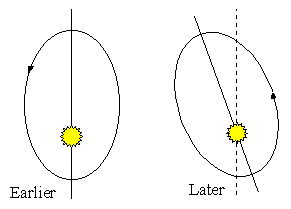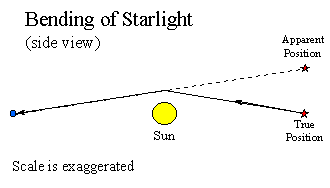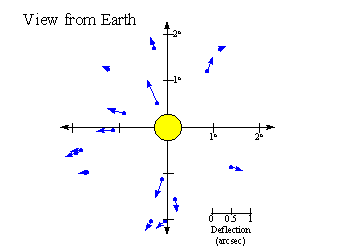He had no hypothesis for what "agent" communicates the
gravitational force across empty space.
People assumed that gravity worked as described by Newton, but didn't
seem to worry about why it worked that way...
The Principle of Equivalence
The first postulate of Special Relativity states:
- The laws of physics are the same for all uniformly moving
observers.
In 1907, Einstein generalized this statement:
- The laws of physics are the same for any freely falling
observer.
There is no distinction between gravitational and inertial accelerations.
For example, a person sealed in a closed box (no windows) drops an apple
and watches it fall down with an acceleration of 1-g. There are no
experiments that can be performed inside the boxes that will distinguish
between two possibilities:
- They and the box are at rest on the surface of the Earth, and the
apple is accelerated downward by the Earth's gravity at 1-g.
- They and the box are in free space accelerating upwards at
1-g by constantly burning rocket engines, and the apple appears
to accelerate downwards because the floor of the box rises up
to meet it.
Both views of the situation are equivalent and indistinguishable.
General Relativity
Gravitation binds matter to matter.
But how does matter "know" that the other matter is
"out there"?
The Goal: Generalize Relativity
- Special Relativity uses light to unify space & time into
spacetime, but leaves matter separate.
- Need to unite matter & gravity through the agency of spacetime.
Enter Geometry
Newton's laws lead to a geometric description of motion:
Least Action Principle:
- An object moves between two points along the path that takes
the least amount of time.
Use geometry to describe the paths of objects moving through
space.
But,
Einstein showed:
- Space & Time are relative, not absolute.
- Only spacetime is observer-independent.
Modified the Least Action Principle:
- An object moves along the shortest path between two
points in spacetime.
Need to describe the geometry of spacetime.
The Shortest Path...
On a flat surface:
- The shortest path between two points is a straight line.
- Parallel lines stay parallel always.
On a curved surface:
- The shortest path is a curved line.
- Lines that start parallel can converge or diverge at some
distance away.
Geometry the Unifier
In empty space, spacetime is flat:
- The least paths are straight lines.
Moving objects follow straight lines.
Newton would have said:
- "It moves in a straight line because it feels no external
force to change its motion."
Curved Spacetime
Matter curves the spacetime around it:
- The least paths are curved lines.
- More mass = Greater spacetime curvature.
- Closer = Greater spacetime curvature.
A freely falling object follows a curved path.
Newton would have said:
- "It feels a force deflecting it from a straight line
path."
A New Theory of Gravity
General Relativity may be summarized as follows:
- Matter tells spacetime how to curve.
Curved spacetime tells matter how to move.
This replaces the Newtonian idea of a "force" with the curvature
of spacetime as the agent of Gravity.
GR has so far withstood all experimental tests.
[Note: The summary statement above is due to physicist John Archibald
Wheeler, who also coined the term "black hole" in the 1960s].
The Precessing Orbit of Mercury
Mercury's orbit major axis precesses slowly by
approximatesly 574 arcseconds/century:

Einstein 1, Newton 0
Newtonian gravity:
- Predicts ~531 arcseconds/century.
- ~43 arcsec/century smaller than observed.
General Relativity:
- Spacetime curvature changes as Mercury gets closer to the
sun on its orbit.
- Gives the orbit a little twist.
- This adds an extra 43 arcsec/century!!
Bending of Starlight
Light travels on the shortest path through spacetime.
Prediction:
- Gravity bends light passing a massive object.
Confirmed: during the 1919 Total Solar Eclipse.


Another manifestation of gravitational bending of light by
massive objects is the phenomenon of "strong gravitational lensing".
This is seen in some massive clusters of galaxies (and a few individual
galaxies) with bright objects (galaxies or quasars) directly behind them.
The Hubble Space Telescope has made some spectacular images
of such gravitational lenses:
The huge masses of the galaxy clusters acts like a lumpy lens,
distorting the images of more distant galaxies far behind them into
luminous arcs. You can see an analogous effect by holding a lens at
arm's length and looking at how distant objects are distorted as the
lens passes between you and them.
Whither Newton?
Newton's laws are approximations of GR.
Conditions:
- weak gravitational fields
- speeds much slower than the speed of light.
Newton's Laws:
- Work accurately in the "everyday" world.
- Are mathematically much simpler.
So we continue to use and teach Newtonian physics, only resorting to the
more complex mathematics of General Relativity when a full treatment is
required.
However, Relativity (both Special and General) do have real-world
applications. For example, the GPS satellite navigation system.
Return to [
Unit 5 Index
|
Astronomy 162 Main Page
]
Updated: 2006 February 18
Copyright © Richard W. Pogge, All Rights Reserved.





